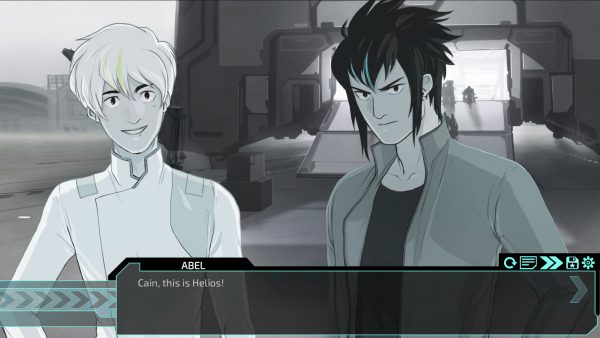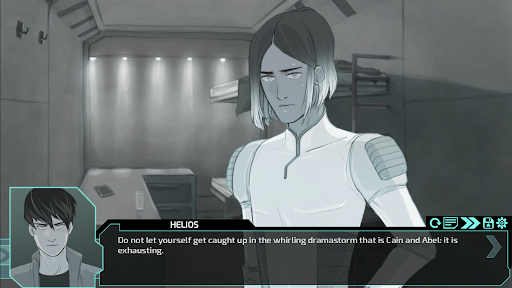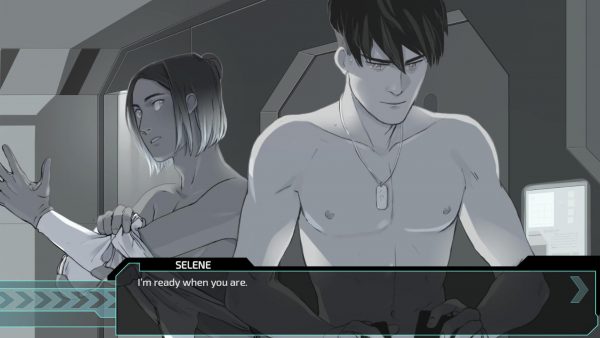
Star-crossed love: Navigating confinement in Starfighter: Eclipse
Eric Cline finds love in a hopeless place.
Dating sims attract players with their open sense of possibility. The promise of slow courtship is enticing, with seemingly no limits to how one’s romance will play out. What new ground might be broken, however, by imposing restrictions on intimacy in the form of militaristically enforced social systems? On a meta level, what possibilities might be explored within the context of a game dependent on another story’s canon and limited to its very specific setting? How does love bloom within such confinements?
Starfighter: Eclipse answers those questions. The game is based on HamletMachine’s cult hit webcomic Starfighter, which follows a promising young cadet named Abel who’s achieved the rank of navigator (essentially a pilot) aboard a military spacecraft. Navigators are paired up alongside fighters (weapons users) in two-person teams, and Abel’s assigned fighter, Cain, soon makes his life a living hell. Though Cain treats Abel horribly, the two immediately form a sexual relationship making it difficult for Abel to view Cain solely in a negative light. As time progresses the pair learn more about one another and must contend with their bond deepening, whether they want it to or not.
It’s this drama that drew readers in and made them willing to shell out money at the prospect of experiencing a similar journey in visual novel format. A successful Kickstarter campaign was launched for Eclipse in 2014, with messaging promising both brand new protagonists and accessibility to new players as well as appearances from the characters series fans already loved. The production had a relatively quick turnaround, with the final product releasing in 2015.

Though Eclipse draws heavily upon its source material visually and thematically, one need not read the source material to understand the game’s plot. The basic gist is as follows: you play as Helios, the newest crewmember on the military spaceship Kepler. An investigative mission regarding an abandoned spacecraft of unknown origins results in chaos, and it’s up to you to help abate the danger while navigating the Kepler’s equally treacherous social climate. Play your cards right and you might find yourself a partner, even if only for a night.
As one might imagine, life aboard the Kepler is quite cramped. Military installations aren’t known for their extensive comforts, and that remains the case in Starfighter‘s futuristic world. The navigation menu offers only eight locations on the ship to travel between, and Helios’s agency in making decisions is often undercut by work obligations or demands from other characters. It’s a cozy vessel and one that doesn’t take long to explore in full.
The flipside of the game taking place within such an enclosed space is that it truly feels lived in. With so few central locations, their differences in tone and function are heightened so that none feel insignificant or redundant in comparison to others. The bridge, for example, serves as the main hub for official business. The medical bay and food hall exist as retreats where social interactions are key and both friendships and resentments form quickly. The observation deck provides a clear view of the stars with which to destress. Helios’s own bunk, meanwhile, can offer tension or reprieve depending on the state of Helios’s romantic endeavors.
It’s these complicated and conflicting social bonds that most clearly exemplify the game’s theme of containment. For context, each of the Kepler’s smaller battle craft has an assigned team of two: one fighter and one navigator, as in the original comic. Navigators are considered the elite given how much harder their positions are to attain, though fighters tend to exert their own sort of (sexual) dominance and are far from lackeys.
Romantic and sexual intimacy is common within fighter/navigator pairs to the point that excessive socializing outside of one’s own pairing is often seen as an attempt to intrude on others’ territory. While there’s some room for polyamorous relations depending on one’s choices (more on that later), by and large crew members are expected not to stray too far from their own assigned team/bunkmates. It’s these social expectations that lead to much of the game’s character drama as the player’s decisions to court or ignore Helios’s own pilot (a young man named Selene) have ripple effects on Helios’s larger social network.

While Starfighter: Eclipse doesn’t have a “true” route the way some visual novels and dating sims do, it would be fair to say that Selene is the primary love interest. He plays a crucial role in resolving the conflict regardless of which route the player completes, and he’s especially competent even for a navigator. Given his status as Helios’s roommate and war partner, there’s no ignoring him either. At the end of the day he’s the character you’re most tethered to, whether you like it or not.
Throughout the game the player’s choices have a direct effect on how Selene views Helios. Sometimes this is a matter of jealousy due to Helios showing interest in another navigator, while other times it’s a matter of Helios just being a dick. (The dialogue options when speaking with Selene range from bluntly flirtatious to cold and dismissive.) Regardless, Selene’s centrality to the narrative creates a unique dynamic for a dating sim. Pursuing any other character triggers drastic consequences for Helios’s social standing and career positioning, reinforcing the sense of constraint and limitation already established by the setting and employer-mandated nature of the relationship.
The game’s myriad endings also reinforce the social pressure to shack up with Selene, as his is the only route wherein Helios’s sexual pairing of choice is implied to both continue after the credits roll or to also include a romantic element. If you stay within your assigned union you are rewarded not just with sex scenes and the promise of love but with the knowledge that you don’t need to watch your back quite so intensely. If you spurn Selene, however, he’s likely to seek a new partner assignment, thus destabilizing the career position you’ve strived so hard to achieve.
Social positioning also plays an important role in a route emphasizing Hayden, Helios’s commander. There’s an obvious power imbalance and that’s the point. Hayden never shows even the slightest bit of romantic interest in Helios, and the pair’s sexual encounters reinforce the confines of their power differential. Helios only gets off when Hayden allows him to, and the reigns of control are never once shared. Helios is a tool, both for Hayden’s sexual pleasure and for assisted surveillance of the rest of the ship’s crew. The sex takes place hurriedly and exclusively in Hayden’s office, confined only to moments when Hayden decides to satisfy his own whims.
Cain and Abel’s routes, meanwhile, contend with a whole other breed of limitations: those created by the game’s source material. As previously mentioned, they are very much a bonded pair. While their romantic arc initially involves revulsion, Starfighter is ultimately the story of their bond developing into one of mutual desire and dependence. In short, Eclipse could hardly have Helios enter a long-lasting relationship with either character without the game’s story feeling utterly irreconcilable with actual canon. The question in game design then becomes how to balance a new choice-based, open-ended narrative with the more linear source material.

Conflict in design arises not just in the different modes of storytelling, but also in players’ expectations and desires. Adhering strictly to comic canon would render Cain and Abel unable to be romanced, but as the main characters, they’re exactly who many players would want to romance. HamletMachine and co. come up with an unexpected solution in Abel’s case: intentionally out of character writing, with his strange behavior attributed to brainwashing.
During the Kepler crew’s aforementioned investigation of an abandoned spaceship, Abel gets knocked out via an alien light-based form of attack that effectively reprograms his brain waves to follow alien directives and sabotage the Kepler’s safety functions and protocols. Along the way not-quite-Abel also sows discord among the crew by acting strangely and against expectations. This includes flirting with newcomer Helios, who—depending on the player’s decisions—either rebuffs the advances or finds himself in the territorial Cain’s (figurative) cross-hairs, as well as spurned by Selene.
With all that said, the limits of adaptation still dictate that Abel not be truly romanceable. Before there’s time for Helios and Abel’s relationship to progress it becomes clear just how unusual the latter’s behavior is, and post-brainwashing Abel even specifically thanks Helios for not taking advantage of him while he wasn’t truly himself. Even as the narrative constructs reasons to temporarily circumvent some social boundaries, it never loses sight of the big picture. Want to romance Abel? Sure, you can flirt with him, but you’re asking for trouble and likely won’t find your relationship’s ending to be a happy one.
Unless, that is, you’re content with the game’s other main workaround concerning the canon’s strict pairings: threesomes. Yes, threesomes. These endings don’t result in polyamorous romantic relationships, but they do provide Helios (and the Starfighter fan/player by proxy) a chance to share a couple’s bed and join in on the fun, just for once.
There are a few different character triangles with unlockable threesome scenes, but the most notable is Cain and Abel’s. Even if you strive your hardest to do right by both men, the best you can hope for is a temporary invitation into their bedroom and nothing more. They have their own pivotal love story to get back to after all, and Helios, as a character exclusive to side media and not the main comic, was never going to become a permanent fixture in their romance. Nonetheless, there’s fun to be had as a temporary third assuming you’re open to such sexual content (and if you decide to play the game after reading any of its promotional material, you probably are).
It’s notable that the game never chastizes the player for what routes and characters they may be drawn to. The franchise’s star pair might not be available for happily ever after style endings, but there’s no editorializing to dictate that any of the one-time flings are inherently more morally wrong or less fulfilling than other possibilities. While it’s possible to finish the game with circumstances that seem grim, these largely stem from choosing to be actively hostile to other characters a la Selene. You, as the player, make your own bed, and your actions determine who shares it with you.

With that said, I could definitely feel the limitations I was brushing up against as I played, particularly with regards to romancing Abel and Cain. I never quite got to experience the degree of emotional intimacy with them I would have liked, and it certainly got irritating to constantly have characters heckle me for straying outside my assigned pairing with Selene. So what if I want to shag someone else for a change?
Alas, individual choice runs counter to the reality of Helios and the other characters’ lives. These are soldiers first and foremost, and they’re only able to bond with each other because they happened to get stationed upon the same ship at the same time. While Helios uses military enlistment as a tool in his search for his missing sister, the military establishment uses him right back. He is a human resource, a body deemed fit to ride within the crafts of war. While victory is always hoped for, the possibility of defeat, and therefore death, is never denied. Though Helios may have chosen to enlist, he is not fighting his own war. He is tasked with following orders, and though he has some degree of freedom in his everyday life it is taken for granted that he won’t place his desires above his responsibilities.
His responsibility to, again, be a body. Given the constant possibility of death, it makes sense for Helios and his cohorts to seek out physical pleasure where (and while) they can. With this in mind, I acclimated more to the lack of happy endings as I kept playing. The danger of military life is reflected in the ease with which it’s possible to get a premature Game Over screen signaling death following a poorly made decision. These critical junctions increase in frequency during the game’s latter half, thus making any survival scenario all the more tolerable in comparison. With the reminder that war is often inescapable, suddenly a hot threesome in the med bay with the comic’s beloved protagonists doesn’t seem like such a bad end result.
Ultimately, Starfighter: Eclipse is a game that defies its own boundaries to deliver stories of love and sex within containment. From the literal confines of a ship far off from human civilization to the unique challenges of basing a visual novel on more linear source material, Eclipse balances the realities that shape all romance: uncontrollable circumstances and the free will to navigate them.
Eric Cline is a writer from the NOVA area. He is a columnist for Haywire Magazine, manga/anime section editor for AiPT! Comics, poetry editor for Angel Rust Mag, and co-host of the podcasts Queering the Guillotine and Chris and Eric’s Longbox Adventure. You can find him on Twitter @ZorakRichardson.